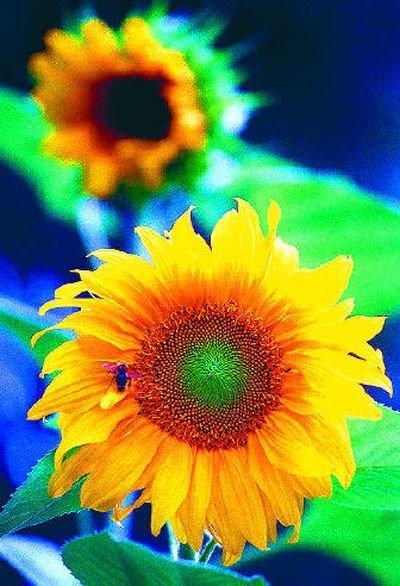Make way for the fun flowers

Few flowers provide as much joy — and instant karma — as the homegrown sunflower.
Simple, straight and very yellow, it shoots up quickly, tilting its massive self this way and that, following the sun like some lumbering coquette.
At least, that’s the popular image of the annual officially known as Helianthus annuus, which comes from the Greek words helios for sun and anthos for flower.
But this North American native is far from common anymore.
Imagine petals cultivated in shades of cream, persimmon or apricot, with centers the color of dark chocolate, lime sorbet or cornbread.
“They’re just magical-looking, nothing like them,” says Ron Kushner of Lafayette Hill, Pa., who likes to plant many-hued foot-highs in the front of his garden border and 15-foot giants in the back.
The colors sound good enough to eat — and plenty of birds and animals love the seeds’ nutty taste. So do humans, especially baseball players and truck drivers.
“We call them spitting seeds,” says Larry Kleingartner, head of the National Sunflower Association in Bismarck, N.D.
For gardeners, color’s the thing, along with the plant’s romping growth rate and blossom size, 4 inches to a foot or more across.
So continue imagining here. You put those many-splendored blooms atop prickly green stalks that come thin as a toothbrush or thick as a baseball bat. The stalks span heights from about 12 inches to — stand back — a “Guinness Book of World Records” 25 feet. More commonly, the tall ones top out at 12 or 15 feet.
Plant a group and the effect is fantastic. You begin to understand why Rebecca Boylan and so many other gardeners are wild about sunflowers.
Boylan’s been growing different varieties for 19 years, since she and her husband moved to a house in Pottstown, Pa., with an acre and a half out back. She favors mixes like ‘Fantasia’ and ‘Pastiche,’ and even created a sunflower tepee in the yard for her son when he was little.
“Sunflowers grow like crazy. They’re very easy. You get instant gratification, and they’re such happy plants,” Boylan says, anthropomorphizing just a bit.
But she may be onto something.
Kleingartner has a similar explanation for why we find this sunny classic so irresistible.
“It’s a very humanlike figure,” he says. “You’ve got the big leaves that look like arms, then you’ve got this face, this friendly, smiling, sunny face.
“I think that appeals to people, especially kids,” says Kleingartner, whose organization comprises 10,000 commercial sunflower-growers in the Upper Midwest and Kansas.
They grow wild sunflowers, which are smaller than the ornamental ones. They also have multiple branches and heads — and are still considered a weed by most farmers.
North American Indians originally cultivated sunflowers to make everything from cooking oil and a coffee-type drink to home remedies and dyes. The Teton Dakota liked to say that when the sunflowers were tall and blooming, the buffalo would be fat and the meat good.
Sunflowers made their way first to Europe and then to the former Soviet Union, which did most of the research that created today’s big-headed, oil-rich varieties. In the 1960s, the gray-and-white-striped seed emerged as a popular snack in the United States.
These days, 60 million acres of sunflowers are grown in 60 countries for their flowers, heart-healthy seeds and oil. While Europeans commonly cook with sunflower oil, it’s just beginning to be used in this country for frying commercial snack foods.
Tom Heaton is a seed man in the purest sense. For 31 years, this California plant geneticist has bred beautiful sunflowers for growing in home gardens and for cutting. He now sells wholesale to 300 seed companies around the world.
More and more, Heaton says, the sunflowers he develops are smaller, more colorful, quicker to flower, and lacking pollen.
“With urbanization, people are getting smaller and smaller areas to plant,” he says, “so the big, tall sunflowers are maybe not as practical or desirable. People just don’t have as much space.”
Many of his offerings are only 3 to 5 feet tall, with 3- to 6-inch blooms. And they come not just in single colors, but in combinations of red-lemon or pink-red-white. Some look more like dahlias than traditional sunflowers.
And most are pollenless. They look the same and still provide nectar for bees and butterflies, but their stems are sturdier and they don’t blanket the dining room table — or your nose and throat — with yellow dust.
All well and good. Still, most of us love sunflowers not for their evolutionary stage, but for being what some have called “a simple miracle.”
Last year, Boylan planted the 3-foot ‘Bashful’; the 10-foot ‘Kong,’ a Heaton-inspired giant; and every size in between in her 4-foot-square herb garden just beyond the kitchen.
“When they grew and flowered, the finches attacked them like crazy,” she says, recalling how she would sit in the kitchen daydreaming or reading the paper and “watching the finch show.”
“It was just beautiful.”